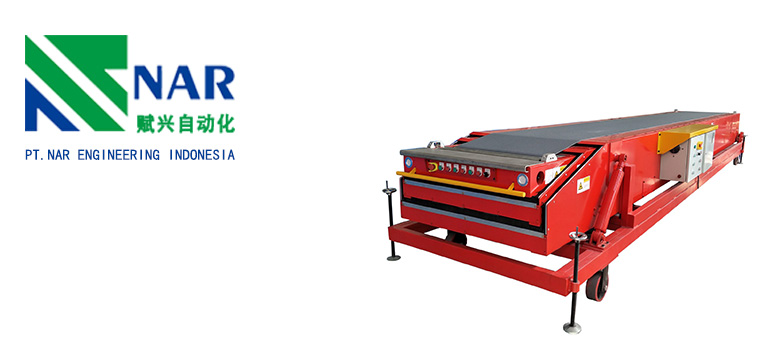Summary:
Elevating Dock Operations with Telescopic Conveyors
What is a telescopic conveyor
The advantages of telescopic conveyors
How to optimize dock operations and telescopic conveyors
In modern logistics and transportation industries, efficiency and speed are key to success. Especially in dock operations, how to handle goods quickly and efficiently is crucial for the company’s operations. In such an environment, the telescopic conveyor demonstrates its unique advantages, providing unprecedented improvements for dock operations. This article will explore the characteristics and advantages of telescopic conveyors, as well as how to use them to improve the efficiency and productivity of dock operations.
What is a telescopic conveyor?

A telescopic conveyor is a type of extendable conveying equipment commonly used to connect trucks and docks during cargo loading and unloading. They are composed of a series of sections that can be extended and retracted, and the length can be adjusted as needed to adapt to vehicles of different sizes and loading and unloading sites.
These conveyors are usually made of steel or aluminum and have the characteristics of being sturdy and durable. They are equipped with conveyor belts or rollers that can quickly and safely transfer goods from vehicles to the dock, or load them onto vehicles from the dock. Telescopic conveyors are usually equipped with electric or hydraulic systems to easily control their length and height.
The advantages of telescopic conveyors
Improve loading and unloading speed
The telescopic conveyor can greatly shorten the loading and unloading time. By directly connecting trucks and docks, they eliminate the traditional manual handling of goods in the loading and unloading process. In this way, goods can be transferred from vehicles to the dock at a faster speed, thereby improving the efficiency and speed of loading and unloading.
Improve staff safety
Compared to manual handling of goods, using a telescopic conveyor can reduce the physical labor and contact hazards of workers. The goods are automatically transported on the conveyor, reducing the risk of accidents and injuries that may occur during transportation. This not only improves the safety of staff, but also reduces the risk of accidental injury, helping to create a safer working environment.
Maximizing the use of space
Due to the adjustable length of telescopic conveyors as needed, they can be flexibly arranged within limited space. This makes them an ideal choice for handling vehicles of different sizes and adapting to different loading and unloading sites. Whether in narrow dock spaces or loading and unloading sites that need to adapt to different types of trucks, telescopic conveyors can maximize space utilization and improve loading and unloading efficiency.
Reduce labor costs
The use of telescopic conveyors can greatly reduce labor costs. The traditional loading and unloading process requires a lot of manpower and time, while the telescopic conveyor can achieve automated loading and unloading, reducing reliance on manpower. This means that the company can save labor costs and allocate resources to other more valuable aspects.
How to optimize dock operations and telescopic conveyors
Choose a suitable telescopic conveyor
Choosing a suitable telescopic conveyor is crucial. This depends on the type of goods, loading and unloading frequency, space limitations of the loading and unloading site, and the specific needs of the company. To ensure that the selected conveyor can meet the loading and unloading needs of the company, and has sufficient durability and reliability.
Training staff
Although telescopic conveyors can greatly simplify the loading and unloading process, operators still need to receive appropriate training. They need to understand how to use and maintain equipment correctly to ensure its safety and efficiency. Providing comprehensive training can help reduce accidents
Regular maintenance and upkeep
Regular maintenance and upkeep are crucial for maintaining the good condition of the telescopic conveyor. This includes cleaning, lubrication, inspection, and maintenance of various components of the equipment. Regular maintenance can extend the service life of equipment, reduce failures and downtime, and maintain the continuity and efficiency of loading and unloading operations.
Optimize layout and workflow
Optimizing the dock layout and loading and unloading workflow can further improve efficiency. Ensure seamless connection between the telescopic conveyor and other loading and unloading equipment and processes, and minimize the number of times goods are handled and transferred during the loading and unloading process. By carefully designing the layout and workflow, the efficiency and productivity of dock operations can be maximized.
The telescopic conveyor provides a fast, efficient, and safe loading and unloading solution for modern dock operations. By improving loading and unloading speed, enhancing staff safety, maximizing space utilization, and reducing labor costs, they can significantly improve the efficiency and productivity of dock operations.
Choosing a suitable telescopic conveyor, training staff, regular maintenance and upkeep of equipment, and optimizing layout and workflow are key steps in optimizing dock operations and telescopic conveyors. By implementing these measures, the company can achieve faster, safer, and more efficient loading and unloading processes, thereby improving overall operational efficiency and maintaining a competitive advantage.
Finally, it should be noted that although telescopic conveyors offer many advantages, they are not a suitable solution for all situations. Before deciding whether to invest in telescopic conveyors, the company should carefully evaluate their loading and unloading needs, budget, and other factors, and consider consulting with industry experts. Only in this way can the company make wise decisions, maximize the potential of telescopic conveyors, and bring sustained growth and success to its business.
Overall, telescopic conveyors have brought revolutionary changes to dock operations, providing companies with opportunities to improve efficiency and productivity. By selecting, using, and maintaining these equipment correctly, and optimizing the dock operation process, the company can achieve faster, safer, and more efficient loading and unloading processes, laying a solid foundation for future development.

